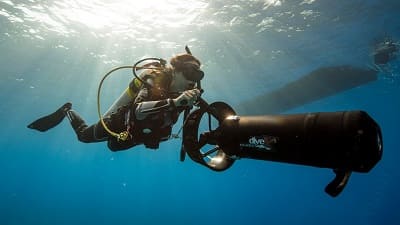Home › A to Z of Diving › Equipment › Accessories › DPV
Diver Propulsion Vehicle (DPV)
There are several reasons why some divers prefer to dive with an underwater propulsion scooter. But, one common reason is to reduce finning so the air supply lasts longer.
This section explains what a Diver Propulsion Vehicle (DPV) is, how they work, and why some underwater scooters are better than others - especially for beginners.
What is a DPV Scooter and Does it Go Fast?
In general, you will be able to cover a large area underwater if you are using a diver scooter. But, they are also handy for:
- Conducting underwater inspections
- Conserving your air consumption
- General exploration exercises
- Performing search and recovery operations
A dive scooter gives you the ability to navigate around the perimeter of large objects (e.g. shipwrecks) or reach out of the way dive sites.
This particular item of scuba diving equipment is motorised and battery-powered. As a result, only commercial and technical divers used them in large-scale practical applications - until quite recently.
Best Diver Propulsion Vehicle for Recreational Divers
Nowadays, DPVs have become popular with sport divers, mainly because they facilitate 'effortless' swims. Even so, because you'll be less active and water will be constantly running over your body, you should be wearing increased thermal protection to avoid issues with hypothermia.
It's important to be clear about the two different types. Unless you want to sit on (straddling) the device, you may be better suited to the type that has a handle. In other words, as the machine moves forward it will tow your body behind it.
 The 'ride on' type of scooter DPV tends to be bigger - and so they are more expensive.
The 'ride on' type of scooter DPV tends to be bigger - and so they are more expensive.
But, this model will provide most comfort over long journeys.
How Fast Can a DPV Diving Scooter Go?
Depending on which power setting you are using, it would be unusual for the battery to last more than two (2) hours.
Underwater scooters with adjustable speed options generally reach speeds up to five (5) kilometres per hour (3 mph).
Of course, the size, shape, and "streamlining" of the diver will have a significant effect on the ultimate operating speed.
Plus, managing the speed of the scooter conservatively will reduce the likelihood of running out of battery power before you need to surface (e.g. low air supply).
Pro Tip: Taking the PADI® Diver Propulsion Vehicle Diver (scooter course) will help you learn how to pilot a scuba DPV in the water.
Related Information and Help Guides
- Best Surface Signalling Devices Used by Scuba Divers
- Dive Light for Scuba Diving (Underwater Torch for Beginners)
- Underwater Navigation Equipment Used in Scuba Diving
Pro Tip: The short video tutorial [2:23 seconds] presented by Global Underwater Explorers describes how to perform a barrel roll while using a high powered DPV diving scooter.